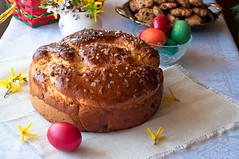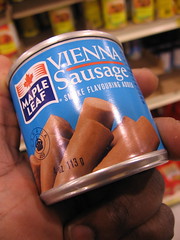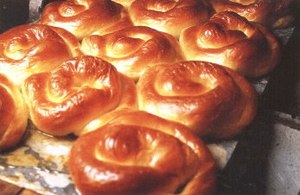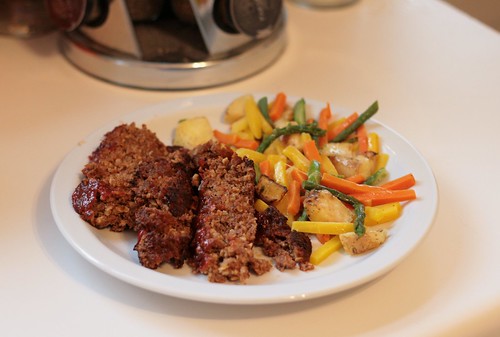Of all the ginataan meryenda recipes that I love, this is simply my favorite. The simplicity of the ingredients plus the salty sweetness of corn gives this a five star from my list of desserts. My sister-in.law adds slices of jackfruit to give it a much nicer aroma. I myself adds small tapioca pearls.
My favorite ginataang mais. (Photos by SDeluz)
Ingredients:
4 cups coconut milk (or 2 cans of 400 ml each)
1 can cream style corn
pinch of salt
1/2 cup glutinous rice
1/2 cup granulated sugar
optional: slices if jackfruit and 1/2 cup tapioca pearls
Procedure:
1. Boil coconut milk and washed glutinous rice (+ tapioca pearls) for 15 minutes until rice is cook.
2. Add corn and salt. Simmer for 5 minutes.
3. Put in sugar (+jackfruit) and mix until incorporated. Cook for two more minutes.
4. Serve and enjoy!
See, that easy! I love easy home cooked meals. Now share me your favorite desserts.
Family gatherings, reunions, house warmings, special occasions. What do they all have in common aside from nice company and fun? Of course, food. It is the basic ingredient in all functions. This is a collection of all shared recipes, expert advice, how to's and tips from friends and the different tastes of culture as experienced by the author. Plus much needed information in making an easy fine menu at home. Online learning about cooking and baking through different established schools.
Thursday, March 31, 2011
Easter Bread (Russian)
 Image by joana hard via Flickr
Image by joana hard via FlickrIn many European countries, there are various traditions surrounding the use of bread during the Easter holiday. People in Russia eat an Easter bread that is full of plump white raisins and tastes like cake. In some countries of Eastern Europe, people enjoy an Easter Cake called babka. It's shaped like a skirt -- babka means "little old woman". Easter cakes in Italy are shaped like a rabbit, which is a symbol of birth and new life and many other countries make cookies and cakes shaped like a lamb, a symbol of Jesus. Hot cross buns are another traditional Easter bread with icing in the shape of a cross.
This is a good recipe for children to learn bread baking techniques. Kids especially enjoy measuring in the ingredients, punching the dough down and the glorious smell the baking dough makes in the house!
Ingredients:
1 cup butter or margarine
1 1/2 cups white sugar
2 cups warm water
2 cups milk (warm)
2 tsp salt
2 pkg yeast
8 eggs
12 to 14 cups of flour
Ingredients:
1 cup butter or margarine
1 1/2 cups white sugar
2 cups warm water
2 cups milk (warm)
2 tsp salt
2 pkg yeast
8 eggs
12 to 14 cups of flour
Glaze
1 1/3 C confectioner's sugar
1 1/2 tsp. finely chopped lemon zest
1/2 tsp. lemon extract
1- 2 T milk
Procedure:
1. Dissolve yeast in warm water.
2. Beat eggs for 5 minutes, then add sugar very gradually, beating all the time. Beat 10 minutes longer.
3. Add warmed milk, yeast and half the flour, mix into thick batter.
4. Add melted butter or margarine, mix well.
5. Continue adding flour until stiff like bun dough.
6. Set aside, rise 1 hour, punch down and let rise again.
7. Bake in large (apple juice tins, etc) well greased pans - fill about 1/5 can as it rises very high. May also be baked in loaf pans.
8. Bake at 350 Fahrenheit until done.
9. Ice with glaze (just mix all the glaze ingredients together and drizzle over bread).
Tip: Add raisins only of the kids like it!
Ginataang Munggo
Ginataang Munggo (Photos by SDeluz)
Ingredients:
1 can coconut milk (400 ml.) or 2 cups coconut milk
2 cups water
1/2 cup Mung Beans
pinch of salt
1/2 cup granulated sugar
1/2 cup glutinous rice
Toasted mung beans. (Photos by SDeluz)
Procedure:
1. Toast the mung beans in a pan. Once brown, take it off the fire and pound with mortar and pestle. Winnow it.
2. Boil the coconut milk with water and add in the washed glutinous rice and toasted mung beans. Bring to a boil, then lower the temperature.
3. Stir occasionally for 30 minutes adding hot water when consistency becomes too sticky.
4. Once rice and beans are done, add sugar and salt. Serve hot or cold based on your preference.
Browsing through my friend's Facebook photos made me do a double take, for nestled in her new posts was this recipe. It's a childhood food that I have seem forgotten and can't even remember when I've last tasted. Cravings to recapture the taste made me rush to the Asian store to purchase needed coconut milk.
So upon my feverish desire to bring back old memories, here is Ginataang Munggo (Guinataang Monggo). A Filipino afternoon treat made up of sticky rice (glutinous rice), toasted mung beans, coconut milk and sugar. Tell me what you think!
Ingredients:
1 can coconut milk (400 ml.) or 2 cups coconut milk
2 cups water
1/2 cup Mung Beans
pinch of salt
1/2 cup granulated sugar
1/2 cup glutinous rice
Toasted mung beans. (Photos by SDeluz)
Procedure:
1. Toast the mung beans in a pan. Once brown, take it off the fire and pound with mortar and pestle. Winnow it.
2. Boil the coconut milk with water and add in the washed glutinous rice and toasted mung beans. Bring to a boil, then lower the temperature.
3. Stir occasionally for 30 minutes adding hot water when consistency becomes too sticky.
4. Once rice and beans are done, add sugar and salt. Serve hot or cold based on your preference.
Wednesday, March 30, 2011
12 Things to Know about Pasta
 Image via Wikipedia
Image via WikipediaWith over 500 different types of pasta available, it is one of the most popular foods in the world today. It is incredibly versatile and can be served in a ton of different ways.
Pasta is a generic term for foods made from an unleavened dough of wheat or buckwheat flour and water, sometimes with other ingredients such as eggs and vegetable extracts. Pastas include varieties that are filled with other ingredients like ravioli and tortellini.
Pasta is typical of different cultures and countries, but the most famous varieties and recipes come from Italy. There are hundreds of different shapes of pasta with at least locally recognised names. Examples include spaghetti (thin strings), maccheroni (tubes or cylinders), fusilli (swirls), and lasagne (sheets). Gnocchi and spätzle are sometimes considered pasta; they are both traditional in parts of Italy.
Pasta is categorised in two basic styles: dried and fresh. Dried pasta made without eggs can be stored for up to two years under ideal conditions, while fresh pasta will keep for a few days under refrigeration.
Pasta Shapes
When making delicious pasta dishes, be sure to choose a pasta shape and sauce that complement each other. Thin, delicate pastas like angel hair or thin spaghetti, should be served with light, thin sauces. Thicker pasta shapes, like fettuccine, work well with heavier sauces. Pasta shapes with holes or ridges like mostaccioli or radiatore, are perfect for chunkier sauces.
Different Kinds of Pasta
Angel hair pasta is an appropriately named cut of thin and delicate strands. They are called "capelli d'angelo" in Italian. |
Armoniche are ridged pasta shapes that resemble small harmonicas. |
Bucatini, also known as perciatelli, are hollow, spaghetti like pasta shapes. |
Cannelloni are pasta tubes, about 1 inch 2.5 cm) in diameter and 3 inches (7.5 cm) long, that are stuffed with savory fillings and usually accompanied with a sauce. |
Cannoli shells are delicate, deep-fried tubes about 4 inches (10 cm) long, used for desserts and stuffed with various fillings. The traditional southern Italian dessert called cannoli is filled with ricotta and candied fruit peel. Packaged shells are available in Italian delicatessens. |
Cappelletti is a variety of filled egg pasta formed into small, circular hat shapes. It is similar to tortellini. |
Conchiglie, literally "conch shells," is a shell-shaped pasta that comes in a variety of sizes. |
Farfalle, meaning "butterflies," is a cut of pasta that is also called bow ties. Both names reflect the shape of the pasta. |
Fedelini is a variety of pasta cut into very fine, thin spaghetti. |
Fettuccine, Italian for "ribbons," is a popular cut of long, flat strands of pasta about 1/4 inch (6 mm) wide. |
Fusilli is a thin spiral shaped pasta that can range from about 1-1/2 inches to 12 inches long. Fusili is best used with thick, heavy sauces. |
Garganelli are pasta shapes that look like small, ridged, folded tubes. |
Gemelli, Italian for "twins," are pasta shapes composed of two strands twisted around each other. |
Gnocchi refers to small dumplings, usually made of potato dough, and to small dumpling-shaped pasta. |
Lasagne are broad, flat noodles used to make the dish known as lasagna. They are available fresh and dried. Also available are "no-boil" lasagne noodles, which have been pre-cooked and redried, allowing them to be layered for baking directly from the package. |
Linguine, Italian for "small tongues," are long, narrow ribbons of pasta resembling flattened spaghetti. |
Macaroni are curved, elbow-shaped tubes of pasta, sold in a variety of small and medium sizes. |
Mezzelune is a variety of filled egg pasta is formed into half moons. |
Orecchiette are pasta shapes that resemble ears, hence their name, which means "little ears." |
Orzo refers to a variety of small pasta that is the size and shape of rice. |
Pappardelle are flat ribbons of pasta, usually about 1 1/4 inches (3 cm) wide. |
Penne, meaning "quills" in Italian, are tubes of pasta that have angled ends resembling pen nibs. They are available smooth or ridged (rigate). |
Radiatori are rectangular and grid like pasta shapes that resemble tiny radiators. |
Ravioli are squares of fresh egg pasta usually formed into small squares to hold a variety of fillings. |
Rigatoni are moderately sized tubes of pasta with grooved surfaces. |
Ruote are shapes of pasta that resemble wheels. They are also known as rotelle. |
Spaghetti, a classic cut of pasta, are thin, round strands. |
Tagliarini are thin, narrow ribbons of pasta about 1/8 inch (3 mm) wide. |
Tagliatelle are very thin ribbons of pasta about 1/4 inch (6 mm) wide. |
Tortellini is a variety of filled egg pasta is formed into small rings. They are available fresh or dried. |
12 Things you need to know about Pasta
- Recipes that call for pasta usually intend for you to use dried pasta, since sauces cling to it better.
- The best dried pasta is made from 100% durum wheat semolina, and has a rough surface, the better to absorb sauces.
- Fresh pasta absorbs flavors and works best with cream or cheese sauces. It cooks faster than dried pasta.
- Use lots of water when cooking pasta, at least a gallon per pound. You can add salt to the water if you wish, but don't add oil. Bring the water to a rolling boil before adding the pasta. When the water returns to a boil, lower the heat to maintain a low boil. Stir occasionally to keep the pasta from sticking together. Don't cover the pot.
- Pasta is ready when it's "al dente." It should be cooked completely through, yet firm enough to offer some resistance to your bite.
- Drain the pasta in a colander, but don't rinse it unless you plan to use it in a casserole or pasta salad. Reserve a small amount of the flavorful cooking liquid in case the pasta becomes too dry and needs to be moistened. Serve it as soon as possible.
- For pasta salads, select short, thick tubes or shapes of dried pasta for pasta salad. Don't use egg pasta or fresh pasta.
- For casseroles, select tubes with thick walls or sturdy shapes. Cook them for two-thirds of the recommended time in water, then let them finish cooking in the oven.
- Different kinds of pasta cook at different rates, so select shapes of similar sizes if you're combining them.
- If you use a low-quality pasta, be sure to cook it in plenty of water to prevent it from getting gummy.
- Don't freeze cooked pasta unless it's in a baked casserole.
- Many pasta shapes comes in different sizes. The Italian suffix "ini" means smaller (e.g., spaghettini is a thin version of spaghetti), while "oni" means larger.
Don't be afraid to try out new pasta. This is all part of learning through experimenting which is a good tip online cooking schools can give you.
Embotido
 Image by El Negro Magnifico via Flickr
Image by El Negro Magnifico via FlickrEmbutido is a type of meatloaf prepared Filipino style. Though a well known dish for the holidays, Embutido can be enjoyed everyday without any hassle. Several meat processing companies now produce this meatloaf for commercial purposes; all you have to do is grab one from your favorite grocery store. But if you like to cook and would like to earn extra, try this recipe and market it at your place. It can easily be kept in deep freezer for future consumption.
Ingredients:
2 bell pepper finely chopped (preferred 1 red and 1 green)
2 onion finely chopped
2 grated carrots
grated cheese
1/4 c powdered milk
1/4 cup catsup
dash of soy sauce or any liquid seasoning
dash of pepper
1 T salt
1/4 cup raisins
toasted bread, use as bread crumbs
8 raw eggs (scramble) (ratio is -- 4 eggs : 1 k ground meat)
1/3 cup sweet pickle relish
1. Prepare a steamer and set aside. Alternatively, prepare a baking pan and a wire rack and preheat oven to 350°F.
2. In a bowl, combine all the ingredients and mix until well blended.
3. Divide the mixture into 2 to 4 portions (depending on how many you want to make).
4. Spread and flatten the mixture onto the center of each foil, divide the slices of hard cook eggs and Vienna sausages.
5. Place each slices at the center of each mixture. Hold the foil onto your hand and roll until the ends of the mixture covers the eggs and sausages. Alternatively, by holding each ends of the foil, roll the mixture back and forth until it covers the slices of eggs and sausages in the center.
6. Finally, roll the aluminum foil into a tightly packed log about 1″ to 2″ in diameter, sealing on both ends. Repeat with the remaining pork mixture.
7. Place the embutido in a steamer and steam for an hour. Alternatively, place embutido in a wire rack on a baking pan, half filled with hot water.
8. Cover with aluminum foil (Be sure the steam will not escape). Steam-bake in the center of the oven for an hour.
9. Remove from the oven. Let it cool and slice into rings. Serve with your favorite catsup or sauces.
10. Refrigerate unused embutido.
* Some don't like the smell of chorizo. You can omit or add this based on your preference. Some also prefer to fry the sliced chorizo even after steaming it. There's no right or wrong in this. Just as long you were able to thoroughly steam the chorizo. Happy learning online cooking!
Tuesday, March 29, 2011
Korean Beef Barbecue
 |
| Photos by SDeluz |
This is a recipe I learned from a college friend who owned an eatery near our college campus in Las Pinas, Manila. He fries it until it is really dry and adds some toppings. I customized it so that it will be saucy and had it paired with a vegetable. Much nicer with quail eggs but there's no available fresh ones here in Germany.
Ingredients:
.5 kilo beef steak cut into thin slices
4 tbsp soy sauce
1 big lemon (8 kalamansi)
2 big cloves of garlic chopped
5 tbsp chili sauce
4tbsp sugar
broad beans
2tsp flour
Procedure:
1. Mix all ingredients (except broad beans and flour) and marinate overnight.
2. Fry the beef on hot margarine leaving the sauce on the bowl.
3. Mix the 2 tsp flour on the marinate sauce and pour on the beef once it is halfway cook.
4. Add broad beans and simmer til cook.
Spinach Filled Croissant
 |
| Photos by SDeluz |
The cartoon character Popeye the Sailor Man is portrayed as having a strong affinity for spinach, becoming physically stronger after consuming it. A frequently circulated story claims that this portrayal was based on faulty calculations of the iron content. In the story, German scientist E. von Wolf misplaced a decimal point in an 1870 measurement of spinach's iron content, leading to an iron value 10 times higher than it should have been. This faulty measurement was not noticed until the 1930s.
Spinach, along with Brussels sprouts and other green vegetables, is often portrayed in children's shows to be undesirable. So here are some ways of incorporating spinach in your meal without your kids throwing a tantrum about it.
Ingredients:
a package of refrigerated ready-to-bake-croissant
cream cheese (example: Milkana or Philadelphia)
package frozen chopped spinach, thawed and drained
Procedure:
1. Preheat oven based on croissant packaging.
2. Drain excess water and moisture from the spinach by putting it on a colander and pressing with a spoon.
3. Mix spinach and cream cheese on a bowl.
4. Open the packaging and prepare the croissant.
5. Get a butter knife and spread it on the croissant. Don't attempt to make a thick spread for the result will be too soggy.
6. Roll the croissant as instructed and put on a tray. Bake based on the packaging.
Ensaymada (using breadmaker)
 Image via Wikipedia
Image via WikipediaThe Ensaïmada is a pastry product from Majorca, Spain. It is a common cuisine eaten in most former Spanish territories in Latin Americaand the Philippines, which has been continuously made and eaten for a very long time. The first written references to the Majorcan ensaïmada date back to the 17th century. At that time, although wheat flour was mainly used for making bread, there is evidence that this typical pastry product was made for festivals and celebrations.
In the Philippines, a Spanish colony for over 300 years; the Majorcan ensaïmada (commonly spelled ensaymada in Tagalog and Cebuano ) has evolved over the centuries and is perhaps one the most common delicacies in that country, the ensaymada is a brioche made with butter instead of lard, and topped with grated cheese (usually aged Edam, known locally as "queso de bola") and sugar. Upscale versions of ensaymada are also topped with butter cream. It is extremely popular throughout the islands, especially during the Christmas season, when it is often, although not always, eaten with hot chocolate.
Ingredients:
(2-lb dough) - [This yielded 9 ensaymadas and 12 pcs spanish bread]
2/3 c milk
1/2 c water
1 egg
2 egg yolks
6 tbsp butter
1-1/2 tsp salt
4-1/2 c bread flour
1/2 c sugar
1-1/2 tsp BM yeast
Procedure:
1. Add ingredients to bread machine pan in the order suggested by manufacturer. Set in dough cycle.
2. Once done, punch dough, lay on the table and roll with a rolling pin to make it flat. (NOTE: To keep the surface of dough from drying up, cover with plastic while you work on the ropes.)
3. Using dough cutter, make long ropes (about a foot long) about 3/4 of an inch wide, and coil.
4. Apply melted butter on coils and let rise for 10-15 minutes (or up to 30 if you want them really fluffy) in a draft-free moist enough area (I like putting them in oven with a bowl of hot water).
5. You may apply egg glaze prior to baking (if you want it darker brown upon baking).
6. Bake at 350 for 12-15 minutes (depending on your oven).
7. You may apply melted butter as soon as they get out of the oven. Helps keep them soft by preventing too much moisture loss. Then apply softened butter and roll in sugar when ready to consume.
I for one haven't done this recipe with a breadmaker. I do plan to invest in my own breadmaker one of these days, but not yet. I have made the dough myself and you will see the recipe in the other Ensaymada post. Based on my friend, she used this recipe and the result is much more softer version as compared to doing the dough by yourself. What I do know is that nothing beats the smell of oven fresh bread in the morning.
Again, thank you Shirley C-R for this recipe. If you want your recipe to be featured, then share it to us. After all, we all learn new things by experimenting.
Again, thank you Shirley C-R for this recipe. If you want your recipe to be featured, then share it to us. After all, we all learn new things by experimenting.
Sunday, March 27, 2011
Bacon Smokies
This is an easy recipe to bring for potluck gatherings. Few ingredients that will produce enough for everyone. Cocktail hotdogs will do in lieu of wieners.
Wiener is a German sausage named after Vienna.
Photos by SDeluz
Ingredients:
- 1 pound sliced bacon, cut into thirds
- 1 (14 ounce) package beef cocktail wieners
- 3/4 cup brown sugar, or to taste
Procedure:
- Preheat the oven to 325 degrees F (165 degrees C).
- Refrigerate 2/3 of the bacon until needed. It is easier to wrap the wieners with cold bacon. Wrap each cocktail wiener with a piece of bacon and secure with a toothpick. Place on a large baking sheet. Sprinkle brown sugar generously over all.
- Bake for 40 minutes in the preheated oven, until the sugar is bubbly.
Tip: Put Aluminum foil on the tray before baking. This is for easy clean-up afterwards.
You want a dip to go with this? Then try Bacon Smokies Dip.
You want a dip to go with this? Then try Bacon Smokies Dip.
Subscribe to:
Posts (Atom)













